 |
 |
 |
| |
NNRTI Resistance in Naives 16%. Changes in Regional Prevalence, Clade and Epidemiology of HIV-1 Drug Resistance Mutations and Clade among Antiviral Therapy-Naive Patients in the United States (US) from 2000 to 2007
|
| |
| |
LL Ross, L Dix, B Wine, C Vavro, J Horton, and KA Pappa
GlaxoSmithKline, Research Triangle Park, NC, USA
INTRODUCTION
Pre-existing HIV drug resistance-associated mutations (Mut) may jeopardize first-line antiretroviral therapy (ART) success when drugs affected by the drug resistance-associated Muts are prescribed1. Changes in the overall prevalence of resistance Muts, as well as by drug class, by subtype, and by geographic distribution were analyzed over time for HIV-infected, ART-naive patients seeking ART treatment for HIV infection from 2000-2007
From Jules: in Figures 1a and 1b this study reports finding NNRTI resistance approximately doubled in naives from 6-8% in 2000 to about 17% in 2007. In Figure 1b NRTI resistance increased from about 3% to 4% from 2000 to 2007 and for PIs from about 2% to 3%.
AUTHOR CONCLUSIONS
Although it has been predicted that the prevalence of HIV resistance-associated mutations in ART-naive subjects could be on the decline, in this large cohort of U.S. HIV infected subjects resistance mutations increased from 2000-2007, whether analyzed by the IAS-USA or Stanford definitions of resistance-associated mutations.
The prevalence of NNRTI mutations increased significantly from 2000-2007. 15% of ART-naive subjects tested in 2007 had IAS-US-defined NNRTI mutations.
K103N was the most frequently detected mutation of all the drug classes.
Subjects with HIV triple class resistance were rare (<1%).
Multivariate analysis using the Stanford or IAS-USA definitions gave similar, but not identical results.
By one or both definitions, black subjects were significantly less likely than whites/other to have acquired PI or NRTI mutations but not NNRTI mutations.
Subjects indicating a heterosexual risk factor were significantly more likely to have acquired HIV with a major PI mutation.
Overall, older subjects are less likely to have acquired HIV with a major IAS-USA PI mutation; however, this trend is reversed in the Midwest, as older subjects were more likely to have acquired HIV with a Major PI mutation. Similarly, this trend is reversed for black subjects, as older black subjects were more likely to have acquired HIV with a major PI mutation than younger black subjects.
RESULTS
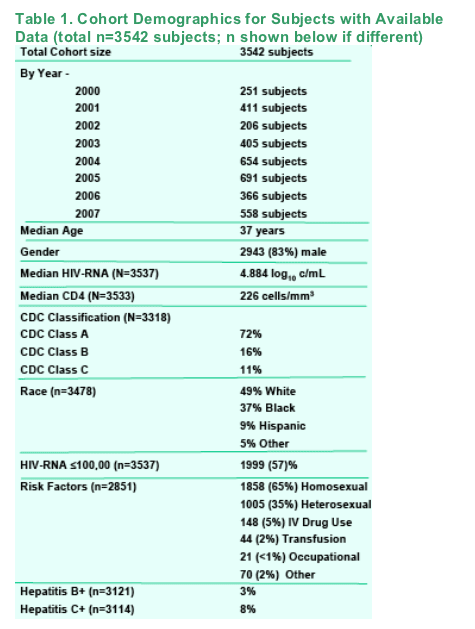
HIV RT and /or protease genotype data was obtained from 3542 antiretroviral-naive U.S. subjects located in 36 states (plus the District of Columbia). The cohort demographics are presented in Table 1.
The incidence of any resistance associated Muts from all 3 drug classes (as one group) for the entire cohort from 2000-2007 was 17% using the IAS-USA defined primary Muts list and 12% using the Stanford Mut list (Figure 1a).
By drug class, the overall prevalence of NRTI, NNRTI and major PI Muts using the 2007 IAS-USA guidelines were 4%, 13%, and 3%, respectively, and by the Jan 2008 Stanford guidelines were 5%, 7% and 3%, respectively. The prevalence of all classes of resistance Muts over time from 2000- 2007 of specific classes of resistance Muts, as determined by either Mut definition are shown in Figure 1b.
A significant increase in IAS-USA defined NNRTI resistance-associated Muts (OR 1.08; Std Err 0.07; p=0.003) or Stanford (Std Err 0.1; p=0.004) as well as in the combined incidence of IAS defined primary resistance associated Muts from all three drugs classes (OR 1.08; Std Err 0.08; p<0.001) was seen from 2000-2007. The difference in the NNRTI prevalence between the two definitions was driven primarily by the presence of the recently added V90I, A98G, V179D and V106I mutations in the IAS-USA 2008 NNRTI definition (first added in the Fall 2007 update) but which are not in the Stanford surveillance mutation list (v.1).
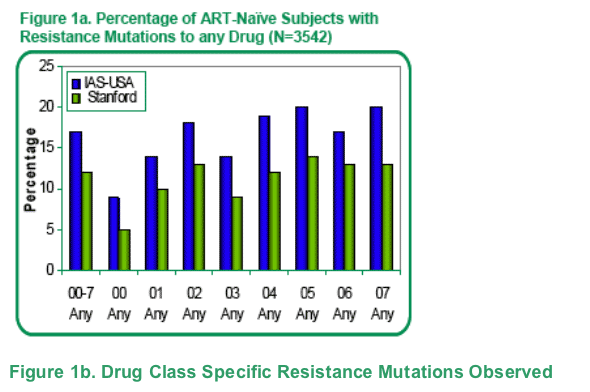
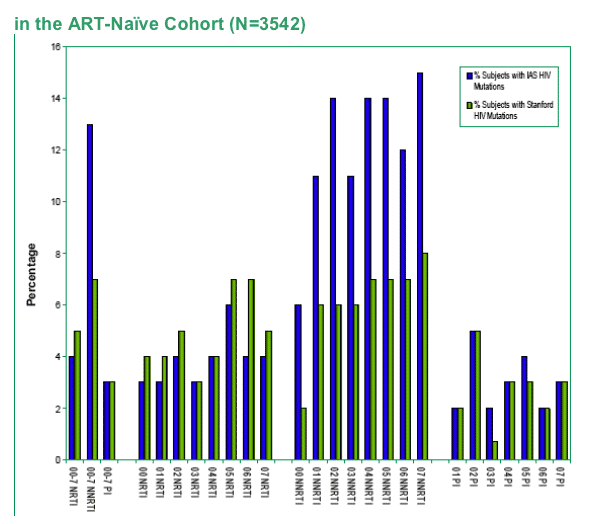
Detection of resistance-associated Muts to a single drug class accounted for most of the resistance observed in these subjects using either the IAS-USA (15% from 2000-2007, range ) or the Stanford definitions of resistance-associated Muts. Between 2000-2007 the median incidence of ≥2-class resistance was 2% (range:<1-4%) by either IAS-USA (overall dual class resistance observed in 63/3542 subjects) or Stanford definition (overall dual class resistance observed in 50/3542 subjects) ; The overall incidence of triple class resistance from 2000-2007 was <1% (IAS-USA: 16/3542; Stanford: 15/3542).
By geographic region, the overall IAS-USA drug resistance-associated Mut incidence for the South was 17%, Northeast:15%, Midwest:15%, and West: 20%. Changes in prevalence over time for each region are shown in Figure 2 (groups with ≦20 subjects not shown). When analyzed by region using Stanford's list of Muts, the overall drug resistance-associated Mut incidence between 2000 to
2007 was 12% for the South, 10% for the Northeast, 10% for the Mid-west and 13% for the West. When yearly prevalence was examined (Figure 2), the Midwest also tended to have a lower prevalence of resistance Muts compared with other regions for both IAS-USA and Stanford defined resistance Muts.
Analysis of the cohort (n= 3105, 2001-2007) using 2005 subtype reference set from the Los Alamos database gave a determination of 97% Subtype B, with C: 1.3%, G: 0.55%; A: 0.45%; D: 0.1%, F: 0.03% and chimeric mixes, including B/A (.06%), B/D (.16%), B/F (0.6%), B/G (0.1%) or A/G (0.6%). The change in prevalence over time is shown for all non-B and for clade C (Figure 3).Non-clade B increased slightly through 2006, although a decrease in prevalence was observed for 2007 in the U.S. Indeterminate mixtures were resolved from 1.77% to 0.1% after the cohort was re-analyzed using the 2005 subtype reference rather than the 2001 subtype reference set.
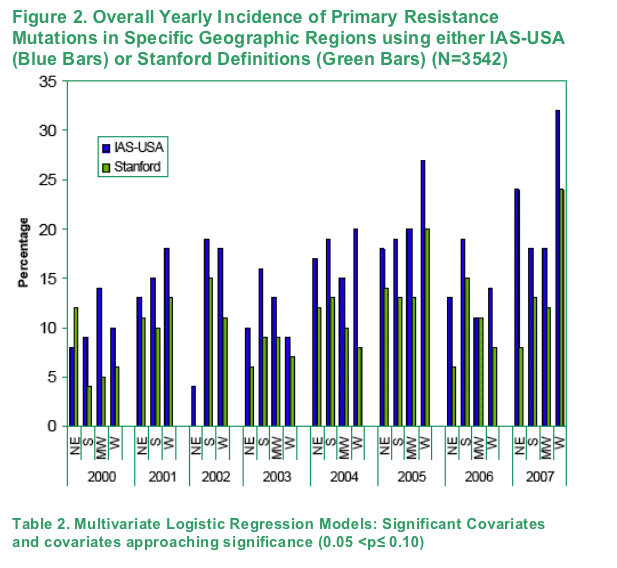
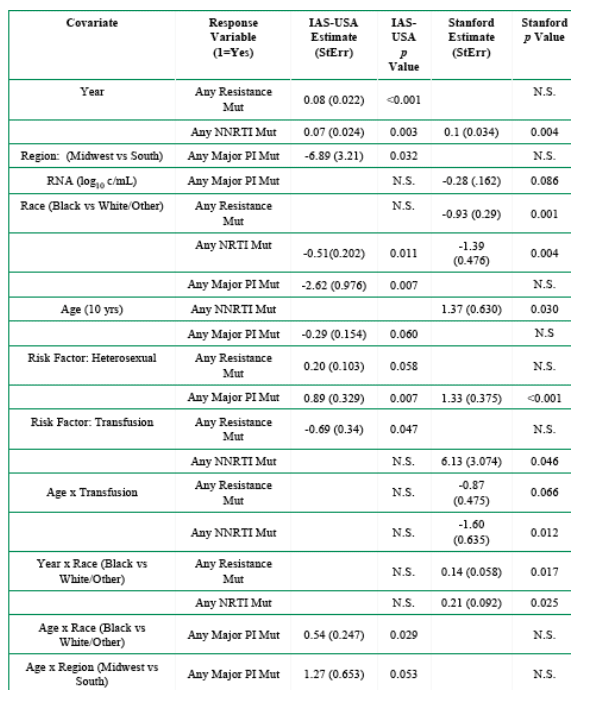
Table 2: IAS-USA Defined Mut Multivariate Analysis Results:
-- Were consistent with the univariate results (data not shown). The Heterosexual risk factor was associated with an increased probability of a PI Mut. Transfusion risk was associated decreased probability of any IAS Mut.
-- Blacks were less likely than whites/others to have any NRTI or Major PI Mut.
-- As the years (time) increased, so did the probability of having any IAS Mut or any NNRTI Mut.
-- In the interaction of Age with Race, while overall an increase in age is associated with a decrease in the probability of any PI Mut, this is reversed in the black subgroup compared to Hispanic and white/other with odds ratio for age of 1.18, 0.60, and 0.69 in the three subgroups.
-- In the interaction with Age and Region, it is the Midwest region in which a reverse trend is observed, with odds ratio for age of 3.29, 0.49, 0.46, 0.88 in the Midwest, West, Northeast, and South subgroups, respectively.
Table 2: Stanford Defined Mut Multivariate Analysis Results :
-- Were consistent with the univariate results (data not shown) except for Age when modeling any NNRTI Mut due to Transfusion risk factor interaction; thus the interpretation of Age may depend upon the presence or absence of the Transfusion risk factor. In the interaction with Year with Race, we are observing a quantitative interaction - odds ratio 1.20, 1.21, 1.04 in the Black, Hispanic, and White/Other subgroups for any Stanford Mut and 1.26, 1.13, 1.023 for any NNRTI Mut.
-- The Heterosexual risk factor was associated with increased probability of major PI Mut; Transfusion risk was associated with an increased probability of NNRTI Mut.
-- Blacks were less likely than whites/others to have any Stanford or NRTI primary resistance Mut.
-- Year as a linear variable was significant in the multivariate analysis of any NNRTI response variable. As the years increased, so did the incidence of Muts.
-- In the interaction of Age with the Transfusion risk factor, while overall an increase in age is associated with a decrease in the probability of any PI Mut, this is reversed in the subgroup of subjects with a Transfusion risk factor compared to those without - odds ratio for age of 2.11 and 0.90 in the two subgroups for any Stanford Mut and 3.92 and 0.81 for any NNRTI Mut.
The prevalence of specific HIV-1 resistance associated Muts detected in this ART-naive population from 2000 through 2007 is shown in Figure 4. Muts detected in HIV from >15 subjects (<0.4%) are presented. NNRTI mutations were the most commonly observed at incidences >0.4%. K103N was the most prevalent Mut by IAS-USA (4.2%); K103N/S by Stanford (4.4%). The overall prevalence of T215F/Y+ T215C/D/E/I/S/V/T (Stanford definition) was 1.8%, but 215F/Y (IAS-USA) was observed in HIV from only 5 subjects, so no subset is shown.
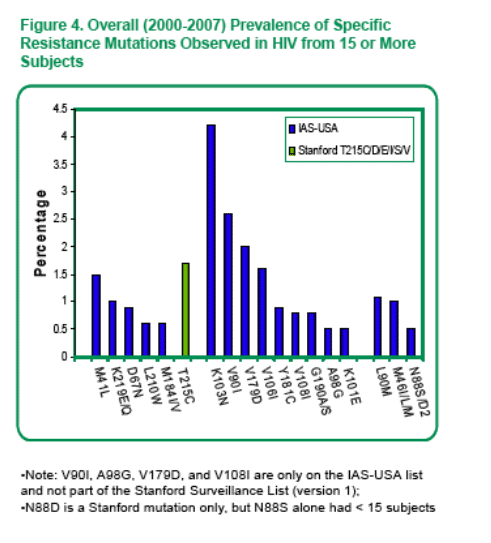

METHODS
Genotypic analysis was performed using plasma-derived HIV from 3542
HIV-infected, ART-naive subjects in the United States within the US
enrolling into GlaxoSmithKline clinical trials between the years 2000 and
2007. Drug resistance-associated Muts were analyzed by 2007 IAS-USA
and by Stanford guidelines. Changes in subtype and drug resistance-associated
Mut frequency over time were analyzed by drug class and geographic region. The overall prevalence and the prevalence by year from 2000-2007 were analyzed. As few samples had protease genotyping from the year 2000, no PI Mut data is presented for that year. Data from any category with ≦20 subjects are not presented.
Resistance-associated Muts were analyzed by two definitions:
1) As per the October 2007 IAS Drug Resistance Mutations Group
(http://www.iasusa.org). Secondary resistance Muts as per this definition were
not included. Primary Muts by class that were included are:
-- NRTI: M41L, A62V, K65R, D67N, T69 insertions, K70E/R, L74V, V75I,
F77L, Y115F, F116Y, Q151M, M184I/V, L210W, T215Y/F, K219Q/E
-- NNRTI: V 90I, A98G, L100I, K101E/P, K103N, V106I/A/M, V108I,
V179D/F, Y181C/I/V, Y188C/L/H, G190A/S, P225H
-- PI: D30N, V32I, L33F, M46I/L, I47V/A, G48V, I50V/L,I54L/M, L76V,
V82A/F/S/T/L, I84V, N88S, L90M
2) As per the Jan 2008 Surveillance Muts list (version 1.0) on the Stanford HIV
Drug Resistance website (http://hivdb.stanford.edu/pages/download/)
-- NRTI: M41L, K65R, D67N/G/Del, T69D/insertion, K70R, L74V,
V75A/M/T/C, V77L Y115F, F116Y, Q151M, M184I/V, L210W,
T215C/D/E/F/I/V/Y, K219E/Q/R
-- NNRTI: L100I, 101E, K103N/S, V106A/M, Y181C/I, Y188C/L/H,
G190A/S/E, P225H, M230L, P236L
-- PI: L24I, D30N, V32I, M46I, I47V/A, G48V, I50V/L, F53L, I54A/L/M/S/T/V,
G73S/T/C/A, V82A/F/S/T/M, I84V/A/C, N88D/S, L90M
Clade analysis was done using the RIP 2.0 program from Los Alamos
(http://www.hiv.lanl.gov/content/hiv-db/RIPPER/RIP.html). For the abstract, the 2001 Subtype reference from the Los Alamos HIV Sequence Database were used as the background alignment. For the poster, the data was reanalyzed using the 2005 Subtype References. Each PR/RT sequence was analyzed with a sliding window of decreasing size (200,150, and 100 nt) until a subtype could be determined. For some samples, full nucleotide sequence was unavailable.
Logistic regression methodology was used to assess the relationship between the presence of IAS-USA or Stanford resistance Muts (any, NRTI, NNRTI and PI in separate models) and potential covariates or factors. The response or dependent variables Muts were classified as either present or not. The probability of Muts being present was modeled. The following categorical covariates or factors that were investigated in the univariate logistic regression models for each of the 4 response variables were Risk Factors: Hemophilia; Homosexual; Injectable Drug; Occupational; Heterosexual; Transfusion; Vertical Transmission; Other risk factors; Gender; Race (Black vs Hispanic vs White/other); Region ("South" as reference). Continuous variables included: Age (10 years); CD4 (100 cells/mm3); RNA (log10c /mL), Year (linear, 0-7 for 2000-2007). Separate logistic regression models were run with each covariate for the 4 response variables (any, NNRTI, NRTI, PI) using the Stanford and the IAS-USA defined datasets.
All significant covariates from the separate univariate models were then assessed together in the same model for each response variable in a multivariate logistic regression model using stepwise selection (entry into model set at 0.4). All significant covariates and interaction terms from these four models were assessed together in a stepwise fashion to arrive at the final mutivariate model for each response variable." Where there were significant interactions, separate multivariate logistic models were also run for each categorical interaction covariate subgroup for purposes of interpretation.
|
| |
|
 |
 |
|
|